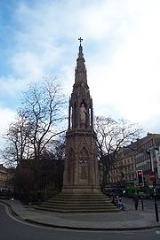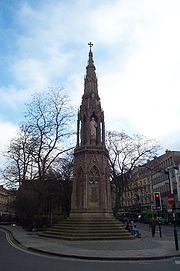
Martyrs' Memorial
Encyclopedia

Magdalen Street
Magdalen Street is a short shopping street in central Oxford, England, just north of the original north gate in the city walls.At the southern end, Magdalen Street meets Cornmarket Street continuing to the south, Broad Street to the east and George Street to the west. At the northern end it...
and Beaumont Street
Beaumont Street
Beaumont Street is a street in the centre of Oxford, England.The street was laid out from 1828 to 1837 with elegant terraced houses in the Regency style. Before that, it was the location of Beaumont Palace, now noted by a plaque near the junction with Walton Street...
in Oxford
Oxford
The city of Oxford is the county town of Oxfordshire, England. The city, made prominent by its medieval university, has a population of just under 165,000, with 153,900 living within the district boundary. It lies about 50 miles north-west of London. The rivers Cherwell and Thames run through...
, England
England
England is a country that is part of the United Kingdom. It shares land borders with Scotland to the north and Wales to the west; the Irish Sea is to the north west, the Celtic Sea to the south west, with the North Sea to the east and the English Channel to the south separating it from continental...
just outside Balliol College. It commemorates the 16th-century "Oxford Martyrs
Oxford Martyrs
The Oxford Martyrs were tried for heresy in 1555 and subsequently burnt at the stake in Oxford, England, for their religious beliefs and teachings....
".
Description
Designed by Sir George Gilbert ScottGeorge Gilbert Scott
Sir George Gilbert Scott was an English architect of the Victorian Age, chiefly associated with the design, building and renovation of churches, cathedrals and workhouses...
, the monument was completed in 1843 after two years' work, having replaced "a picturesque but tottering old house". The Victorian Gothic memorial, whose design dates from 1838, has been likened to the steeple of a cathedral. The three statues of Thomas Cranmer
Thomas Cranmer
Thomas Cranmer was a leader of the English Reformation and Archbishop of Canterbury during the reigns of Henry VIII, Edward VI and, for a short time, Mary I. He helped build a favourable case for Henry's divorce from Catherine of Aragon which resulted in the separation of the English Church from...
, Hugh Latimer
Hugh Latimer
Hugh Latimer was a Fellow of Clare College, Cambridge, Bishop of Worcester before the Reformation, and later Church of England chaplain to King Edward VI. In 1555, under Queen Mary, he was burnt at the stake, becoming one of the three Oxford Martyrs of Anglicanism.-Life:Latimer was born into a...
and Nicholas Ridley
Nicholas Ridley (martyr)
Nicholas Ridley was an English Bishop of London. Ridley was burned at the stake, as one of the Oxford Martyrs, during the Marian Persecutions, for his teachings and his support of Lady Jane Grey...
are by Henry Weekes
Henry Weekes
Henry Weekes, RA was an English sculptor, best known for his portraiture. He was among the most successful British sculptors of the mid-Victorian period....
. The monument is listed at grade II*.
The inscription on the base of the Martyrs' Memorial reads as follows:
- "To the Glory of God, and in grateful commemoration of His servants, Thomas CranmerThomas CranmerThomas Cranmer was a leader of the English Reformation and Archbishop of Canterbury during the reigns of Henry VIII, Edward VI and, for a short time, Mary I. He helped build a favourable case for Henry's divorce from Catherine of Aragon which resulted in the separation of the English Church from...
, Nicholas RidleyNicholas Ridley (martyr)Nicholas Ridley was an English Bishop of London. Ridley was burned at the stake, as one of the Oxford Martyrs, during the Marian Persecutions, for his teachings and his support of Lady Jane Grey...
, Hugh LatimerHugh LatimerHugh Latimer was a Fellow of Clare College, Cambridge, Bishop of Worcester before the Reformation, and later Church of England chaplain to King Edward VI. In 1555, under Queen Mary, he was burnt at the stake, becoming one of the three Oxford Martyrs of Anglicanism.-Life:Latimer was born into a...
, Prelates of the Church of EnglandChurch of EnglandThe Church of England is the officially established Christian church in England and the Mother Church of the worldwide Anglican Communion. The church considers itself within the tradition of Western Christianity and dates its formal establishment principally to the mission to England by St...
, who near this spot yielded their bodies to be burned, bearing witness to the sacred truths which they had affirmed and maintained against the errors of the Church of RomeRoman Catholic ChurchThe Catholic Church, also known as the Roman Catholic Church, is the world's largest Christian church, with over a billion members. Led by the Pope, it defines its mission as spreading the gospel of Jesus Christ, administering the sacraments and exercising charity...
, and rejoicing that to them it was given not only to believe in Christ, but also to suffer for His sake; this monument was erected by public subscription in the year of our Lord God, MDCCCXLI".
Cuthbert Bede (in his novel The Adventures of Mr Verdant Green) wrote about the setting of the Martyrs' Memorial thus in 1853:
- "He who enters the city, as Mr GreenVerdant GreenVerdant Green is a fictional undergraduate at Oxford University, as featured in the Victorian novel The Adventures of Mr. Verdant Green, by Cuthbert M. Bede . He was a student at Brazenface College, a fictional college....
did, from the Woodstock Road, and rolls down the shady avenue of St Giles', between St John's CollegeSt John's College, Oxford__FORCETOC__St John's College is a constituent college of the University of Oxford, one of the larger Oxford colleges with approximately 390 undergraduates, 200 postgraduates and over 100 academic staff. It was founded by Sir Thomas White, a merchant, in 1555, whose heart is buried in the chapel of...
and the Taylor Buildings, and past the graceful Martyrs' Memorial, will receive impressions such as probably no other city in the world could convey."
The actual site of the execution is close by in Broad Street
Broad Street, Oxford
Broad Street is a wide street in central Oxford, England, located just north of the old city wall.The street is known for its bookshops, including the original Blackwell's bookshop at number 50, located here due to the University...
, located just outside the location of the old city walls. The site is marked by a cross sunk in the road.
History
As well as being a monument to the Reformation, the memorial is also a landmark of the 19th century Oxford MovementOxford Movement
The Oxford Movement was a movement of High Church Anglicans, eventually developing into Anglo-Catholicism. The movement, whose members were often associated with the University of Oxford, argued for the reinstatement of lost Christian traditions of faith and their inclusion into Anglican liturgy...
, propagated by John Keble
John Keble
John Keble was an English churchman and poet, one of the leaders of the Oxford Movement, and gave his name to Keble College, Oxford.-Early life:...
, John Henry Newman and others. Profoundly alarmed at the Catholic
Catholicism
Catholicism is a broad term for the body of the Catholic faith, its theologies and doctrines, its liturgical, ethical, spiritual, and behavioral characteristics, as well as a religious people as a whole....
realignment the movement was bringing into to the Church of England
Church of England
The Church of England is the officially established Christian church in England and the Mother Church of the worldwide Anglican Communion. The church considers itself within the tradition of Western Christianity and dates its formal establishment principally to the mission to England by St...
, the Rev. Golightly and other low church
Low church
Low church is a term of distinction in the Church of England or other Anglican churches initially designed to be pejorative. During the series of doctrinal and ecclesiastic challenges to the established church in the 16th and 17th centuries, commentators and others began to refer to those groups...
Anglican clergy raised the funds for erecting the monument, with its highly pro-Protestant and anti-Catholic inscription, as a public propaganda move. As a result the monument was built 300 years after the events it commemorates.
The condition of the Memorial deteriorated in the twentieth century, but it underwent a full restoration in 2003, funded by Oxford City Council and the Oxford Preservation Trust
Oxford Preservation Trust
The Oxford Preservation Trust was founded in 1928 to preserve the city of Oxford, England. The Trust seeks to enhance Oxford by encouraging thoughtful development and new design, while protecting historic buildings and green open spaces....
.
Popular rumour amongst some tour guides is that in the past students have misled foreign tourists about the nature of the Memorial and convinced them it was the spire of an underground church. This would result in the tourists venturing down a flight of stairs near the Memorial which actually lead to the public toilets.

